Although only three unseeded players have ever succeeded in winning the French Open crown, the tournament is generally perceived as the bastion of ‘Dark Horses’. It is at the French Open that we see World Number Ones struggling to find their feet and being handed defeats by journeymen.But, French Open, which is currently the sole Grand Slam being played on clay, evokes a certain visceral desire in the tennis fan that no other Grand Slam does. It is at Roland Garros that we witness tennis players indulge in rallies that last over 30 strokes on a regular basis.While ‘The Championships at Wimbledon, owing to the death of the serve-and-volley game, has lost some of its lustre, the French Open has not only survived but has retained its most enchanting allure, seemingly immune to the many changes in tennis technology.Let us now take a look at the five most successful French Open Champions in the Open Era.
#5 Gustavo Kuerten (3)
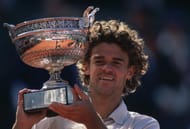
Gustavo Kuerten was the first Brazilian to win a Grand Slam title in the Open Era, a feat he achieved in 1997, when he took out two-time French Open champion Sergi Bruguera in the final.
Kuerten was ranked 66 in the world, heading into the 1997 French Open and was not on anyone’s list of favourites to take the cup that year. But, en route to the final, he took out defending champion Yevgeny Kafelnikov and former French Open champion Thomas Muster to set the Roland Garros tennis complex abuzz with his feat.
With a wiry backhand that he fired with effortlessness and a forehand which he brandished like a whip, Kuerten was, as the cliché goes, a delight for sore eyes.
Kuerten’s victory at Roland Garros in 1997 was rendered so much sweeter since it was his maiden ATP tour title. It was a classic case of the underdog beating the champion.
After below-par performances at the French Open in ’98 and ’99, Kuerten renewed his affair with the tournament at the break of the millennium, in 2000, beating Alex Corretja in the final to clinch his second French Open crown. In a replay of the 2000 title match, Kuerten emerged triumphant again in ’01, winning his third and last French Open, Grand Slam crown.
Of the 20 ATP tour titles that Kuerten won, 14 of them were won on clay, making him one of the most successful players on the surface in recent times.
#4 Mats Wilander (3)
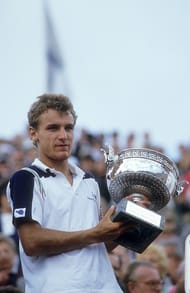
1982 was a monumental year in the history of French Open. The year witnessed, for the first time, an unseeded player win the crown.
Playing in what was only his third Grand Slam event, Mats Wilander, a 17-year-old unheralded player from Sweden shocked the tennis world and many giants of the game along the way to win his first Grand Slam title.
En route to his maiden French Open final in ’82, Wilander upset the likes of Ivan Lendl, Jose Luis Cleric among others. The biggest upset, however, he saved for the final showdown. Up against one of the greatest clay-courtiers in the game in Guillermo Vilas, Wilander took out the former in four sets, even handing him a bagel in the third.
Along with Lendl, Wilander dominated the French Open for most of the 1980s. In the years 1982-88, he won seven Grand Slam titles, three of them coming at Roland Garros. In ’88, he also became the first Swede to win the US Open.
Wilander also ascended to the apex of the World Rankings in September 1988, occupying the pedestal for 20 weeks. Wilander was one of the great masters on clay, winning as many as 20 titles on the surface.
#3 Ivan Lendl (3)
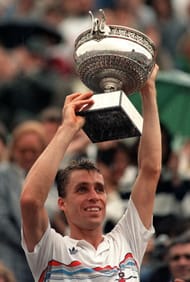
Following what was incontestably the ‘Decade of Bjorn Borg’, the 1980s saw a plethora of tennis stars vying to ensconce themselves on the summit of men’s tennis. Among them were illustrious names such as John McEnroe, Jimmy Connors and Stefan Edberg. Another name, which writes itself easily onto that list, is that of Ivan Lendl, who occupied the World Number One ranking for a jaw-dropping 270 weeks in the 1980s and was arguably the most dominant player of that decade.
Often seen as the pioneer of ‘Power Tennis’, Lendl was nothing short of an expert with the topspin. He relied on his strength to lend that extra advantage to his game. His topspin forehand is still reckoned to be one of the most effective strokes in tennis and he used it as a weapon at the French Open.
Although Lendl had a relatively weak backhand at the beginning of his career, he had succeeded in strengthening it sufficiently by 1984, a year that was to prove a watershed in his career. Faced against McEnroe in the 1984 French Open final, Lendl had to call into service all his resources, including his backhand to win a five-setter, where he came back from being two sets down.
Lendl subsequently went on to win seven more Grand Slam titles, taking his overall tally to eight. At Wimbledon, he finished second best twice, losing to Boris Becker in ’86 and to Pat Cash in ’87. Following his maiden success at the French Open in ’84, Lendl returned to conquer Roland Garros on two more occasions, winning it in consecutive years in 1986 and ’87. Including the three French Open crowns, Lendl won 28 clay court titles in all.
#2 Bjorn Borg (6)
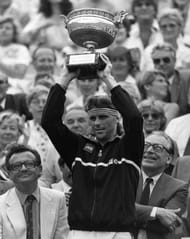
With his long flowing hair and an easy laidback attitude, Bjorn Borg took little time to endear himself to a jovial French crowd.
Borg was, unquestionably, the first superstar of the Open Era. In 1974, Borg was a mere 18 years old when he claimed his first French Open title, beating Manuel Orantes in a gruelling five-set encounter to engrave his name on the title and in history indelibly. The then inexperienced Borg had to rally from two sets down to win the first of his 11 Grand Slam titles.
Despite being an extremely agile mover on the court and boasting a large repertoire of ground strokes, it can still be said that Borg did not possess the flair and elegance of, say, John Newcombe. Neither did his game evoke the visceral excitement that his arch-rival John McEnroe’s did. However, even 32 years after he announced his retirement for the first time (his comeback was a largely forgettable affair), Borg continues to inspire awe and reverence.
While both Nadal and Federer succeeded in winning both the French Open and Wimbledon successively, their accomplishment despite being herculean, cannot be compared to Borg’s, for today, the pace of tennis courts across surfaces is fairly uniform.
In the1970s, however, when tennis was played predominantly with wooden racquets and white balls, the difference between the clay courts of Roland Garros and the lawns of Wimbledon was inexplicably immense. To shift from the slow clay courts of Paris to the rapid courts of Wimbledon, back in the 1970s was a much harder task than it is today. But it was a feat that Borg achieved with almost consummate ease. From 1977-80, Borg won both French Open and Wimbledon, which gives an idea of Borg’s awesome prowess.
#1 Rafael Nadal (9)
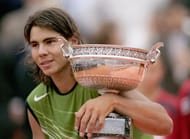
When Rafael Nadal entered the Roland Garros tennis complex in 2005, on the back of an immensely successful clay-court season, he was, without a glimmer of doubt, the overwhelming favourite to win the title. Those who so presciently proclaimed Nadal’s success at the event disregarded the fact that it was the Spaniard’s maiden appearance at the event as a professional.
Roger Federer, who in 2005 was the undisputed World Number one, too had a successful clay-court season, having earned a win at the Hamburg Masters in the week leading to the French Open. The Swiss maestro looked as invulnerable as ever having lost a mere two matches in the run-up to the French Open that year and had clearly set his sights on winning the crown and completing the ‘Career Grand Slam’. But the observers were convinced that even Federer would become a casualty to the Nadal storm.
Heading into his first Grand Slam meeting with Nadal, Federer hadn’t dropped a single set in 2005 French Open and was, predictably high on confidence; confidence, that was blown to smithereens by Nadal, who, despite losing a set, seemed hardly troubled by the Swiss ace. Following his victory against Federer, Nadal beat Mariano Puerta in the title clash to win his first ever French Open (which was also his maiden Grand Slam title).
Nadal’s victory against Puerta heralded the beginning of his domination at the event. Over the next ten years, Nadal slipped just once on the clay of Roland Garros: To Robin Soderling in 2009. That tiny blemish notwithstanding, no Grand Slam has known domination as absolute as Nadal’s on Roland Garros. With nine French Open titles and 46 clay court titles in all, the sobriquet ‘King of Clay’ seems hardly an exaggeration.
What is the foot injury that has troubled Rafael Nadal over the years? Check here
